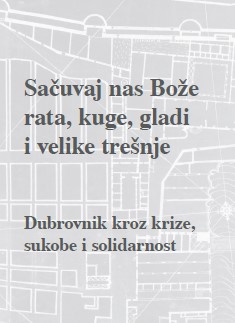Crna smrt 1348. godine u Dubrovniku - godina krize i solidarnosti?
Black Death in Dubrovnik in 1348 - Year of crisis and solidarity?
Author(s): Gordan Ravančić
Subject(s): Local History / Microhistory, Government/Political systems, Security and defense, Health and medicine and law, 13th to 14th Centuries
Published by: Hrvatski institut za povijest
Keywords: Dubrovnik; Croatia; Black Death; Adriatic; plague; 1348;
Summary/Abstract: The plague epidemic/pandemic in the mid-fourteenth century – commonly known as the Black Death – consumed almost the entire European continent in just a few years. Although its spread and causes are fairly well elaborated in existing literature, the extent of the epidemic’s reach in the historical Croatian lands and neighboring medieval Hungary has been less investigated. Still, extant sources from the medieval commune of Dubrovnik (later the Republic of Dubrovnik) provide enough material for a partial reconstruction of events regarding the arrival of disease in the city, reaction of the local authorities, and the course of events during the epidemic. Even though the epidemic of 1348 only lasted for several months in Dubrovnik, extant sources reveal that it left some deep marks in the social tissue of the city, and had at least a temporarily harsh effect on the economic well-being of contemporary Dubrovnik. Namely, since contemporary citizens of Dubrovnik could not comprehend the causes of the misfortune that struck the city, nor did they have an “effective” cure, their local authorities reacted quite reasonably and pragmatically. Since mortality caused by the epidemic instigated a significant administrative slowdown, and some of the healthy inhabitants wanted to escape from the infected city, Dubrovnik authorities produced a series of important – mostly palliative – normative measures, aiming to maintain order within the city and to overcome the troubles that burdened its subjects. At the same time, common people, facing a sudden and probable death, tried to ensure safe passage of their souls to the “other world” by writing their last wills, which today provide an excellent source in reconstructing a social change of medieval Dubrovnik. Therefore, the purpose of this study is to investigate to what extent the epidemic of 1348 was an acute disruption or the beginning of a long-term crisis concerning social change and economic development. Moreover, the investigation of the extant sources will try to give answers to the question of whether this calamity provoked and caused any kind of institutional and personal solidarity among citizens of medieval Dubrovnik.
Book: Sačuvaj nas Bože rata, kuge, gladi i velike trešnje. Dubrovnik kroz krize, sukobe i solidarnosti
- Page Range: 11-34
- Page Count: 24
- Publication Year: 2018
- Language: Croatian
- Content File-PDF

